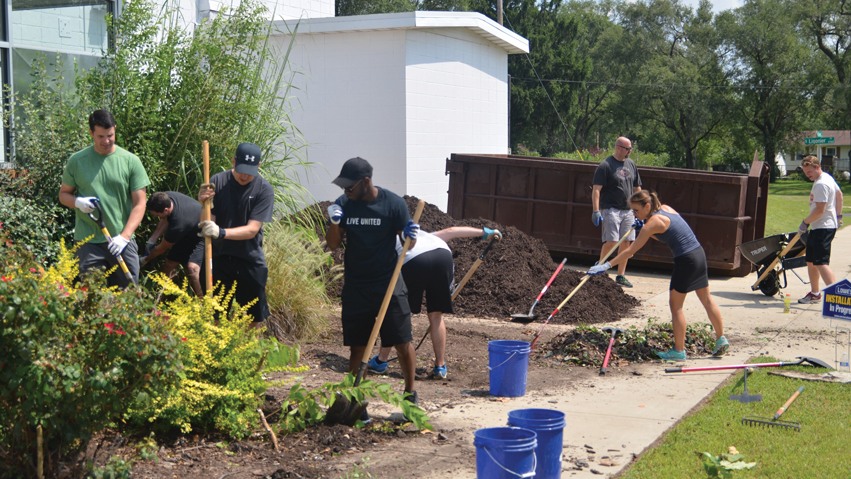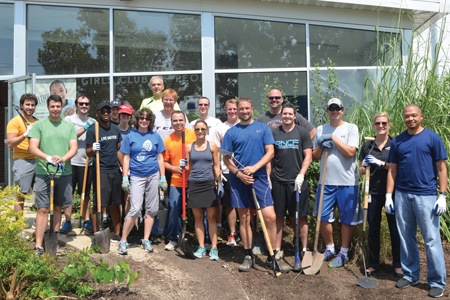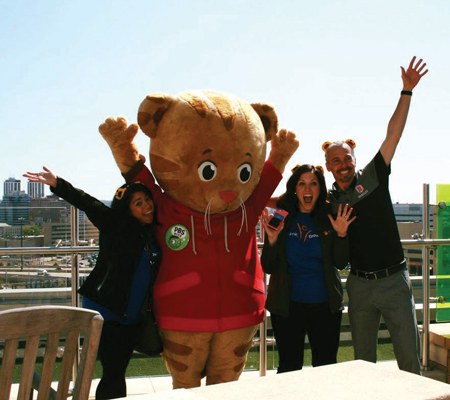
By utilizing outcomes as a measurement tool and focal point, organizations can strengthen their volunteer efforts and community reach.
Volunteers are at the heart and soul of a nonprofit’s work in the community. From home-delivered meals for seniors to tutoring students in an afterschool program, to helping spread mulch on playground or painting a classroom, volunteers can make a difference within all levels of an organization.
But according to a survey of more than 2,500 nonprofit organizations by Software Advice, 45 percent of nonprofit organizations do not actively measure volunteer impact because of a lack of time, resources, tools and skills. One of the first steps a nonprofit can make in evaluating and measuring their volunteer work is to look at outputs and then move towards reporting outcomes.
 Immediate Outputs & Sustained Outcomes
Immediate Outputs & Sustained Outcomes
Measuring volunteer outputs is the easiest and often the first statistic reported when working with volunteers. Outputs are the immediate numbers of what resulted from the work. However, outcomes reflect overall performance because they track specific changes resulting in a transformation of knowledge, attitudes, values, skills, behaviors or conditions. By including outcomes in volunteer program evaluation, nonprofits can better communicate effectiveness, performance and achievement to volunteers and stakeholders.
As a starting point, nonprofits need to first determine the purposeful volunteer outputs that need to be measured by their organization. This data serves as the backbone of reporting volunteer results to staff and the board, as well as the volunteers themselves. Obvious outputs to measure include number of volunteers and hours worked, amount of work completed, and volunteer retention.
The next step in reporting volunteer outputs should be looking at the volunteer footprint within the nonprofit organization, and the return on investment for recruiting and utilizing volunteers. How much money is the organization saving from hiring professional services or staff to complete the work? How much existing staff time and resources are being used to recruit and monitor volunteer work? Tracking these opportunity costs can help streamline and improve an agency’s volunteer strategy.
However, if more volunteers and volunteer hours are not adding up to more community impact for a nonprofit, that is when understanding outcomes and measuring cause impact can lead to working smarter and not harder. It is also vital to the conversion of volunteers to donors.
Comparing the immediate impact of volunteer work to sustained outcomes will help nonprofit organizations better promote their mission and social impact within the community. For example, a program that delivers meals to seniors can easily count the number of volunteers, hours and meals. While these output measurements are all significant to tracking success, ultimately the percentage of seniors who reported feeling safer living in their own homes, decreases in reported isolation, and improved health and nutrition are better indicators of the true impact made by volunteers.
 Caterpillar Team Builds Up a Community
Caterpillar Team Builds Up a Community
In 2016, more than 200 volunteers from Caterpillar Inc.’s Large Power Systems Division, led by Tana Utley, donated hundreds of hours of work to help the Boys and Girls Clubs of Greater Peoria prepare their Grinnell Street location for the start of a new school year. These volunteers repaired the gym’s scoreboard, painted, landscaped, replaced drywall and improved an adjacent pocket park. Working in the heat of August without air conditioning, this team of volunteers went above and beyond to make a difference in this neighborhood.
While the immediate impact these Caterpillar Inc. volunteers had at the Grinnell Street location could be seen in the new plants around the building and the freshly-painted classrooms, the real impact has been on the 160 children and their families who use the site.
Through tutoring and mentoring, Boys and Girls Clubs of Greater Peoria is making a difference in the lives of many students. Since the project at the Grinnell site was completed, 100 percent of students in the afterschool program have successfully been promoted to the next grade level.
“More importantly, the Grinnell Street site has made the children and families in that neighborhood feel valued,” says Lesley Matuszak, chief professional officer of Boys and Girls Clubs of Greater Peoria. “When a child can look up at a volunteer and make a connection, they know they are not forgotten.”
Beyond academic achievement, volunteers who worked at the Grinnell Street location have also increased the sense of community and security in the surrounding neighborhood. Students have a safe place to go after school, and parents know they can trust the services offered by the agency.
“The work at the Grinnell Street location speaks to the type of people who work at Caterpillar Inc.,” Matuszak adds. “They saw the need and provided real support. Working with volunteers is a two-way street. To be successful, you have to show them the outcome of their work.”
Measuring and reporting outcomes to volunteers becomes a powerful means of recognition, retention and recruitment. By reporting outcomes related to volunteer work, it becomes an opportunity for the nonprofit to bring awareness to its mission and work.

PNC’s Grow Up Great initiative helps prepare children from birth to age five for success in school and life. Over the last 14 years, more than $128 million in grants and 700,000 employee volunteer hours have helped more than 3.7 million preschool students. PNC encourages employees to volunteer 40 hours of paid time each year to support the Grow Up Great initiative.
Purposeful Volunteerism at PNC
As a company, focusing on outcomes is also an excellent strategy when developing an effective employee volunteer program. Volunteer Match reports that one of the leading trends for 2018 and beyond is an increased focus on purposeful volunteer opportunities.
PNC Bank believes that every child deserves the opportunity to reach his or her full potential. “We know that learning early and being ready for kindergarten is very important to success in school and later in life as adults,” explains PNC Bank Regional President Brian Ray. “We recognize that providing high-quality early education for all children helps prepare the workforce and community leaders of tomorrow.”
Since 2004, PNC has offered a program called Grow Up Great to help provide children and teachers in preschool and Head Start classrooms with materials and other resources they need. The company has created a bilingual, $350 million, multi-year initiative to help prepare children from birth to age five for success in school and life.
 PNC encourages employees to volunteer 40 hours of paid time each year to support the Grow Up Great initiative. Over the last 14 years, more than $128 million in grants and 700,000 employee volunteer hours have helped more than 3.7 million preschool students. “Our PNC team, specifically in central Illinois, has volunteered more than 6,500 hours and raised more than $130,000 for area pre-K classrooms,” adds Jenna Cicciarelli Wiesner, Vice President, Director of Client & Community Relations for the Office of the PNC Regional President.
PNC encourages employees to volunteer 40 hours of paid time each year to support the Grow Up Great initiative. Over the last 14 years, more than $128 million in grants and 700,000 employee volunteer hours have helped more than 3.7 million preschool students. “Our PNC team, specifically in central Illinois, has volunteered more than 6,500 hours and raised more than $130,000 for area pre-K classrooms,” adds Jenna Cicciarelli Wiesner, Vice President, Director of Client & Community Relations for the Office of the PNC Regional President.
These efforts have directly benefitted more than 3,000 children who participate in the Heart of Illinois United Way’s Success By 6 reading program. PNC volunteers are integral to managing the distribution of 3,000 books each month to more than 135 classrooms in central Illinois. The ultimate outcome of supporting this pre-literacy program has been a 95-percent increase in the children’s interest and curiosity about books, 88 percent who demonstrated improvement in understanding words and sentence structure when being read a story, and 85 percent who improved reading comprehension, which includes identifying characters in the story and asking or predicting what will happen next.
“Not only is providing high-quality pre-K education the right thing to do, it makes good economic sense,” Ray adds. “Studies have shown that high-quality preschool education better prepares children to achieve in school and strive for higher vocational aspirations—and that it has a positive impact on society.”
By utilizing outcomes as a measurement tool and a focal point, both nonprofits and companies can strengthen their volunteer efforts and community reach. By moving from reporting just the number of hours worked by volunteers, to reporting outcomes that illustrate the ultimate results of the volunteer work, nonprofits and companies can put into place a best practice that focuses on tracking and measuring the vital role their volunteers are playing in the community. iBi

